



640 horsepower?
Colour me corrupted.
I drove the first 2021 Porsche 911 Turbo S that arrived in Canada. It was a German-spec car brought over for press demos.
Danke schön, Porsche.
Base list is $231,700 for the Coupé, $246,300 for the Cabriolet.
My coupé tester totaled $241,540, bolstered by a few options that included Porsche Active Suspension Management (PASM - it wouldn't be a Porsche feature without a three- or four-character acronym), a $1,720 hit which lowers the car by 10 mm and brings faster-reacting dampers for improved handling with less compromise in ride comfort.
Together with Porsche Dynamic Chassis Control (sure, PDCC), which changes the anti-sway bar stiffness to reduce body roll in cornering, they further reduce the ride/handling trade-off that has plagued suspension designers forever.
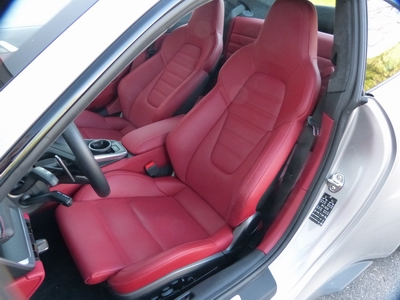 If
you have to choose things like adaptive cruise control ($2,280), lane
change assist ($1,200) and lane-keep assist ($1,390) as in my tester,
maybe you're not really ready for a car like this.
If
you have to choose things like adaptive cruise control ($2,280), lane
change assist ($1,200) and lane-keep assist ($1,390) as in my tester,
maybe you're not really ready for a car like this.
You are supposed to drive this car; it shouldn't be driving you.
Visually, the car is hardly a stealth-mobile. The wider fenders, the unique front and rear fascias, the deployable rear spoiler, and most notably the massive wheels and tires (Pirelli P ZERO, 255/35ZR20 front, 315/30ZR21 rear) with huge brakes (420 mm rotors with no fewer than ten-piston calipers up front, 390 mm four-pots at the rear, painted bright yellow) tell you this is a serious car.
Still, compared to the GT3 RS, it's relatively unadorned. It illustrates the simple beauty of the 911 shape which has been remarkably unchanged over its nearly six decades of history.
The
excellent fit and finish, the minor controls, the comfy and supportive
front seats,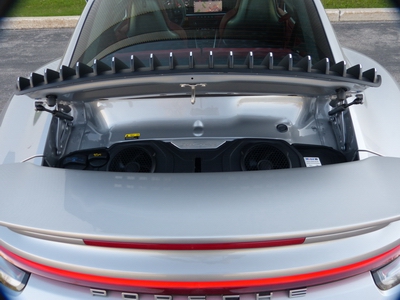 the rear seats designed for circus acrobats, the trunk up front like
an elephant, and the fact that you cannot see the engine at all, are
similar to other 911s.
the rear seats designed for circus acrobats, the trunk up front like
an elephant, and the fact that you cannot see the engine at all, are
similar to other 911s.
I'll focus here on what makes the Turbo S version so different, so special.
The 3.8 litre twin-turbo flat six engine pumps those 640 horses and 590 lb.-ft. of torque through an updated PDK (Porsche Doppelkupplungsgetriebe) double-clutch gearbox.
Fire it up, and the familiar flat-six exhaust growl greets you.
Pull away, and the first thing to strike you - it's quick. Bloody quick.
Throttle
response is RIGHT NOW.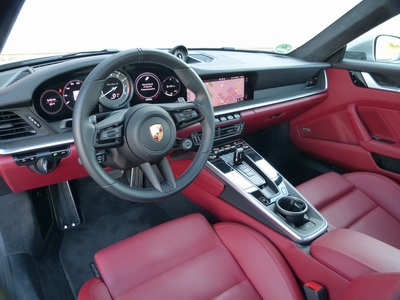
I attempted some 0 - 100 km/h runs on a deserted stretch of dead-end road using the car's built-in timer.
But I was so busy holding on, I couldn't work the buttons fast enough.
These sprints looked drama-free from outside, because thanks to the various control systems there's no wheel spin, just the bellow of the car as it disappears over the horizon.
Trust me; the factory-supplied time of 2.7 seconds is no lie.
Of course, at 100 km/h the car is just catching its breath, on its way to a theoretical top end of 330 km/h.
This makes the Turbo S one of the very fastest cars you can legally operate on Canadian roads.
OK, the "330 km/h'' part is not so legal...
What is most impressive is the continual improvement Porsche has made in reducing turbo lag. In this car there's a continuous surge of power to the red line, upshift, and do it again.
As always, that PDK shifts seamlessly and immediately.
Sure, you can play with the shift paddles, but you won't be able to beat the machine.
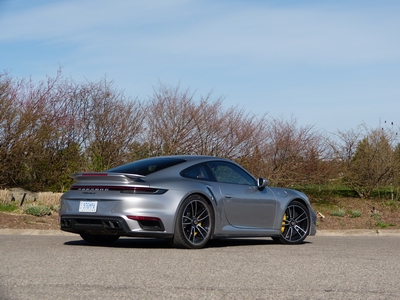 The
shift lever is the same as in other new-generation 911s - forward for
Reverse, back for Drive, push a button for Park. In other words, they
should throw it out and go back to PRNDL - Park, Reverse, Neutral,
Drive, Low. That design ain't broke; stop trying to fix it.
The
shift lever is the same as in other new-generation 911s - forward for
Reverse, back for Drive, push a button for Park. In other words, they
should throw it out and go back to PRNDL - Park, Reverse, Neutral,
Drive, Low. That design ain't broke; stop trying to fix it.
The steering is as precise as you'd expect from a Porsche, and offers what seems to be perfect weight.
The full-time four-wheel drive system is rear-axle biased, but can deliver up to 62 percent of the torque to the front wheels if it deems it necessary to do so.
The torque vectoring system directs drive force to whichever wheel or wheels can best use it. Along with the electronically-controlled limited slip rear differential, it will do its level best to keep you from becoming part of the scenery.
You have a choice of five drive modes via a round knob at the 5 o'clock position on the steering wheel, each of which tailors things like throttle response and transmission reaction to suit.
"Normal'' is - you guessed it - for normal driving conditions.
"Sport'' and "Sport Plus'' up the performance ante in successive, predictable steps.
"Individual'' allows you to choose various settings to your own taste. For example, I set everything to be as "sporty'' as possible, but backed the suspension off to "Normal'' to reduce harshness.
"Wet'' actually measures how damp the road is via sensors in the front wheel wells, and adjusts the settings accordingly. I have tested this on other 911s, and it really works.
In "Sport'' or "Sport Plus'' modes, the PDK will let the engine rev until it hits the red line, but will not automatically upshift. It just chatters away on the red line. You after all are in the driver's seat.
As you slow down, the PDK will stay in whichever gear you've selected until the revs drop too low, in which case it downshifts for you.
But as you re-accelerate to the max, it will again stay on that red line until you hit that right-side paddle.
The
uprated suspension in the Turbo S does the business. Ride quality was
actually not as harsh as I feared, although those ultra-low aspect
ratio tires set up a bit of bump-thump on sharp road irregularities,
of which there is no shortage here in early spring.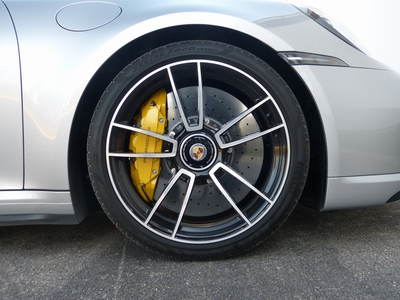
A separate button on the dash allows you to firm up the dampers for even more control. It did make the suspension react more sharply, but frankly, it was difficult to evaluate their handling benefit under these less-than-perfectly-controlled test conditions.
Say, Porsche - when you and Mosport are ready, so am I...
Porsches, especially the more powerful 911s, have a somewhat sinister reputation for tricky on--the-limit handling, what with all that engine weight hanging out aft of the rear axle.
That is pretty much a thing of the past.
Sure, if you shut off all the nanny systems and really ham-fist it, it might get a bit tail-happy.
But as hard as I dared drive this car on public roads, it remained resolutely stable.
Wish your way around that corner; it follows your bidding.
The car is equally adept at just cruising around, comfortable and tractable. Not the least bit fussy.
The satellite radio was not functioning in my car, and apparently there is no AM radio in Germany because all I could get was FM. Still, the BOSE sound system was its usual excellent self.
Every advance in the 911's development has expanded its bandwidth, with more performance at the sharp end, and more comfort at the other.
The Turbo S continues this tradition.
Unlike a lot of exotics, the Turbo S is a car you could live with, day to day, season to season.
Now, you have no doubt heard the old real estate adage that buying the cheapest house in a good neighborhood is the best investment.
You can get a 911 that looks almost the same as the Turbo S for less than half its price.
But if you want the ultimate 911, you'll just have to pony up.
One test drive, and you will be making another call to your bank manager.
FACT BOX:
Porsche 911 Turbo S. Two-door, two-plus-very-occasional-2 passenger sports coupé /convertible. Full-time variable four-wheel drive.
PRICE: Coupé - $231,700; Cabriolet - $246,300; as tested (Coupé) $241,540.
ENGINE: 3.8 l flat-six, dual overhead camshafts, four valves per cylinder, variable valve timing, twin turbochargers.
POWER/TORQUE, horsepower / lb.-ft: 640 @ 6,750 r.p.m. / 590 @ 2,500 - 4,000 r.p.m.
TRANSPORT CANADA FUEL CONSUMPTION, City/Highway, litres/100 km: 15.5 / 8.6. Premium fuel.
COMPETITORS: Audi R8; Mercedes-AMG GT; Nissan GT-R.
WHAT'S HOT: It's fast; it's very fast; looks and handling rank at the very top as well; did I mention it's fast?
WHAT'S NOT: Shift quadrant just has to go; rear seat no better than it has ever been; really expensive.
WHAT'S
INTERESTING: Wonder if they'd take my left arm in on a trade?